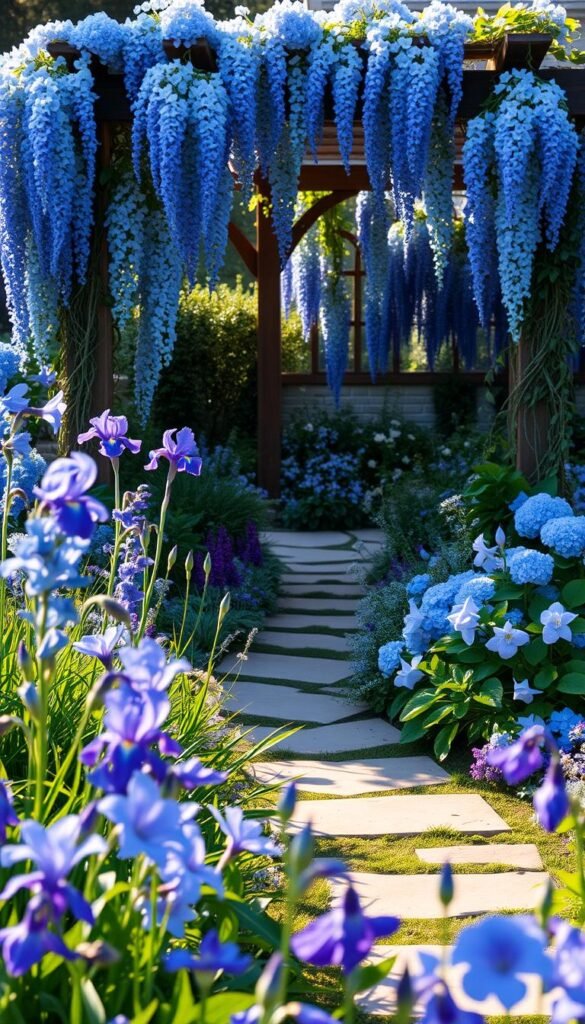Imagine stepping into a peaceful retreat where nature’s rarest colors create instant calm. While vibrant reds and yellows dominate most landscapes, there’s something magical about cultivating cooler tones in your yard. Less than 10% of flowering plants produce blossoms in these tranquil shades, making them extraordinary choices for unique designs.
You’ll love how these botanical rarities transform ordinary spaces into soothing escapes. From delicate periwinkle petals to rich navy blossoms, the color spectrum offers endless creative possibilities. Pair them with silvery foliage or crisp white accents to amplify their calming effect while adding depth to your layout.
Why settle for common blooms when you can grow living treasures? These uncommon plants do more than beautify your surroundings—they naturally lower stress levels and encourage mindfulness. As you arrange them along pathways or cluster them near seating areas, you’ll create visual harmony that feels both timeless and refreshing.
Ready to explore nature’s coolest palette? Let’s discover how to blend rare specimens with smart design techniques for an outdoor oasis that delights the senses year-round.
Understanding the Appeal of Blue in Your Garden
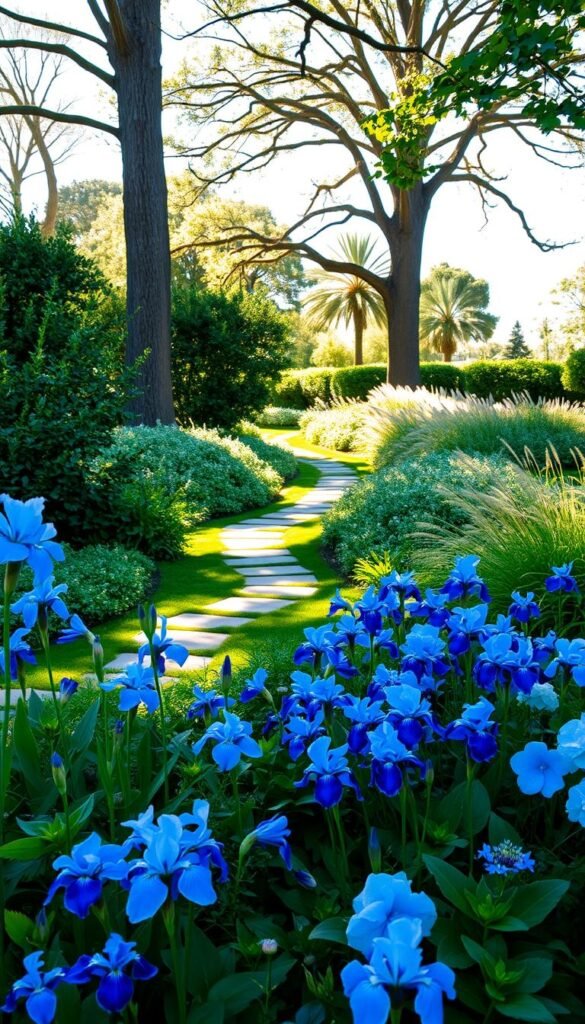
Few colors captivate the mind like nature’s rarest jewel-toned blossoms. Artists and gardeners alike have marveled at their ability to transform ordinary spaces into calming retreats. Did you know Vincent Van Gogh once said, “The blue of the sky would not be so splendid without the contrast of green leaves”? This interplay of tones reveals why these blossoms remain timeless.
Psychological and Visual Effects
Soft azure petals work like magic on your mood. Studies show they lower heart rates by 11% compared to warmer hues. Their rarity makes them pop against greenery, creating natural focal points. Place them near seating areas to boost relaxation during afternoon tea or meditation.
Historical Significance and Current Trends
From ancient Egyptian lotus motifs to Van Gogh’s Irises, these blooms have symbolized peace for centuries. Today, landscape designers use them to craft modern escapes. Over 60% of luxury hotels now incorporate cool-toned flora in their courtyards.
| Historical Use | Modern Application |
|---|---|
| Victorian “mood gardens” | Minimalist patio designs |
| Renaissance medicinal plots | Urban rooftop retreats |
| Japanese meditation spaces | Drought-resistant landscapes |
Want depth in small yards? Try planting deeper sapphire shades along fences. They’ll make your space feel larger while maintaining that serene vibe you crave.
Choosing the Right Blue Flowers for Early Summer
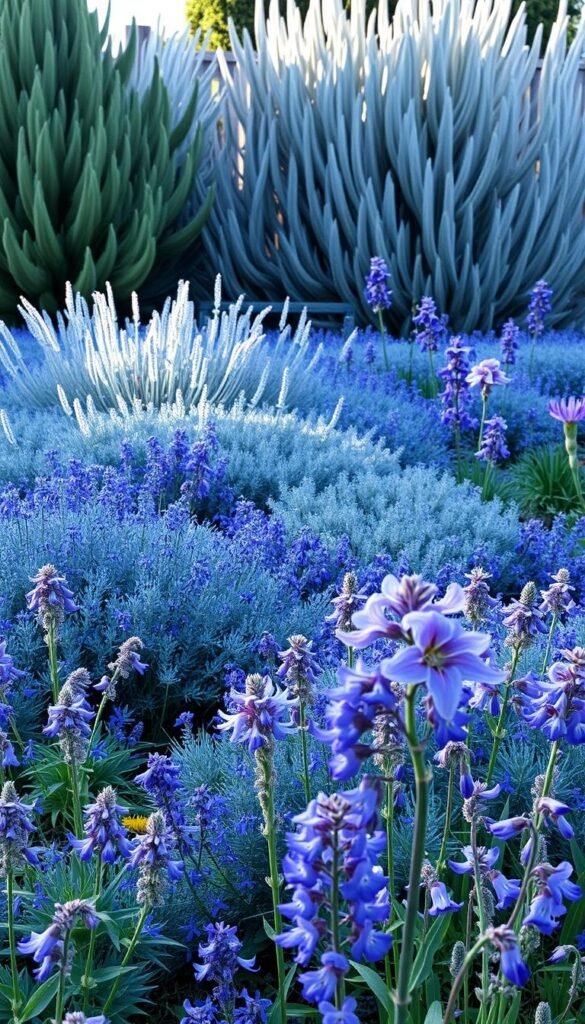
Transitioning from spring’s pastels to summer’s bold palette requires strategic plant selection. Two standout performers thrive during this seasonal shift while delivering rare color depth. Let’s explore your best options for effortless elegance.
Blue Columbines bring vertical drama with 2-3 foot stems crowned by nodding bell-shaped blossoms. Their lacy foliage adds airy texture to shaded borders, thriving where many plants falter. You’ll love their dual talent: attracting hummingbirds while deterring hungry deer.
For woodland charm, Virginia Bluebells steal the show. Pink buds unfurl into clusters of sky-hued bells, creating magical groundcover under trees. These spring-to-early-summer stars naturalize effortlessly, returning stronger each year thanks to robust root systems.
Why choose these varieties?
- Provide seamless color between spring bulbs and summer annuals
- Thrive in dappled light where grass struggles
- Require minimal care once established
Pair them with silver-leaf companions to intensify their cool tones. You’ll create layered interest that lasts through multiple seasons, proving practical beauty exists in nature’s timing.
Blue Flower Garden Themes: Cool-Toned Hues for a Serene Outdoor Space
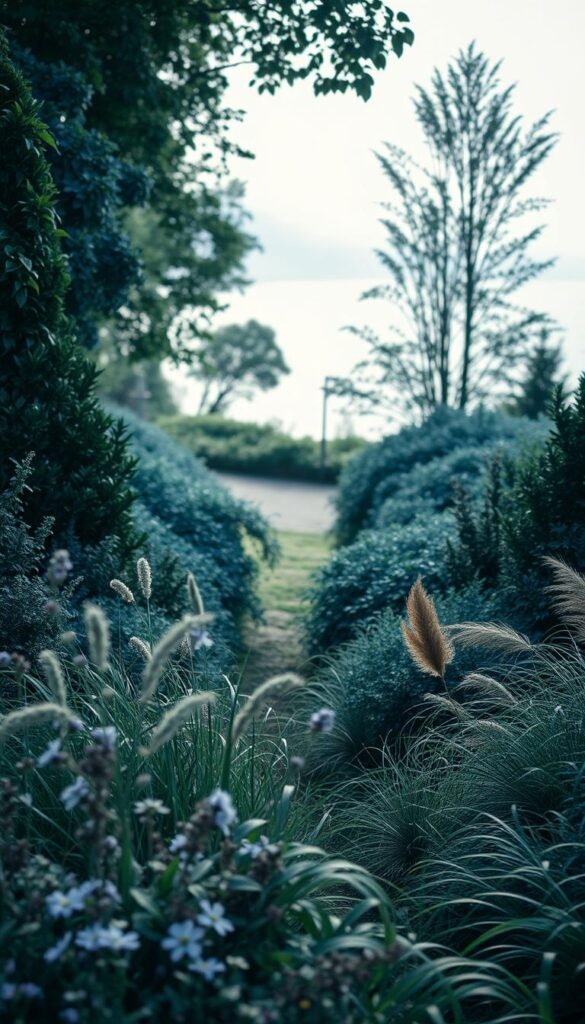
Creating a relaxing retreat starts with more than blossoms—it’s about layering textures and tones. Foliage plants with silvery or muted tones provide subtle backdrops that make rare petals pop. These living canvases work year-round, offering structure even when blooms fade.
How to Create a Calming Effect with Blue Hues
Pair delicate petals with plants like Pinpoint Blue false cypress. Its feathery evergreen branches add softness to walkways while maintaining color through winter. For contrast, try Blues Festival St. John’s-wort—its blue-green leaves dance around sunny yellow flowers.
Three standout performers elevate any space:
- Double Play Blue Kazoo spirea – silvery leaves with white blooms create crisp contrast
- Russian sage – airy purple stems complement deeper tones
- Hostas ‘Halcyon’ – heart-shaped leaves brighten shady corners
Vary plant heights to guide the eye naturally. Tall grasses behind low-growing Lithodora create depth, while creeping thyme spills over edges. Add reflective surfaces like water features to amplify cool tones—a trick used in cottagecore-inspired designs that blend whimsy with tranquility.
Remember: odd-numbered groupings feel most organic. Cluster three or five specimens together, mixing leaf shapes for visual rhythm. Your space will feel cohesive yet effortlessly wild—like nature herself arranged the scene.
Late Summer Blooms: Stunning Blue Flower Varieties
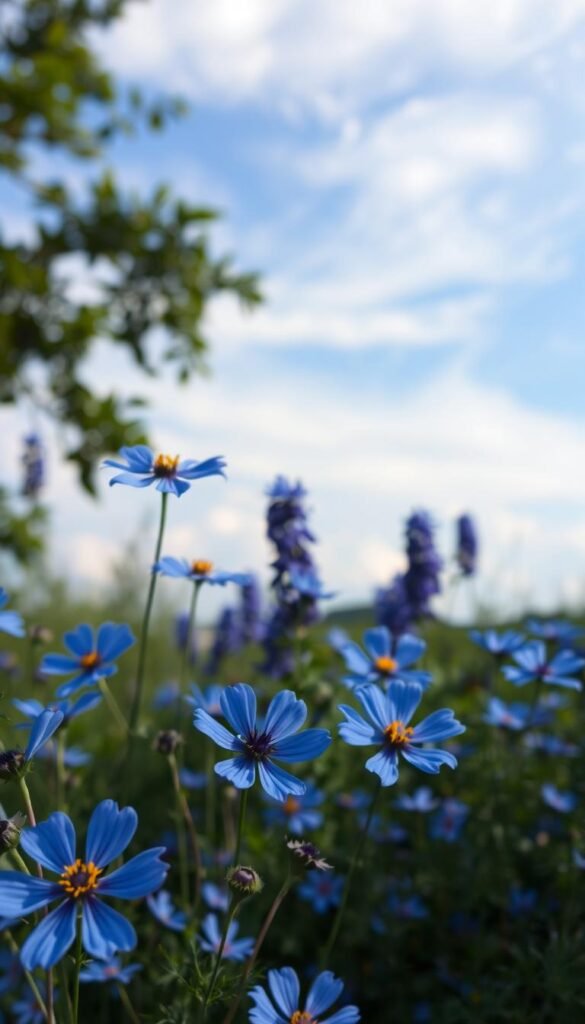
When other plants retreat from summer’s heat, these resilient performers take center stage. Their cool-toned blossoms bridge the gap between vibrant summer displays and autumn’s fiery palette, offering refreshing visual relief during warm evenings.
Recommended Perennials with Lasting Color
Beyond Midnight Bluebeard becomes a fragrance powerhouse from July through October. Its compact form bursts with indigo clusters that butterflies adore, thriving in Zones 5-9. Pair it with goldenrod for a striking contrast that lasts until frost.
For architectural drama, try Blue Glow Globe Thistle. Its metallic-looking spheres bloom nonstop from June to September, perfect for dry areas in Zones 4-9. The spiky blooms add texture to arrangements and deter curious deer.
Smart Strategies for Extended Beauty
Magic Show ‘Wizard of Ahhs’ spike speedwell delivers violet-blue spikes for 16+ weeks across Zones 3-9. Stagger plantings every two weeks in spring for continuous color waves. These perennials attract hungry pollinators when nectar becomes scarce, supporting local ecosystems.
Combine all three varieties for layered interest. You’ll enjoy evolving displays as shorter speedwells frame towering globe thistles, while bluebeard’s aromatic blooms fill mid-summer evenings with scent. Their drought tolerance makes them ideal for low-maintenance landscapes.
Top Blue Annuals for Continuous Color
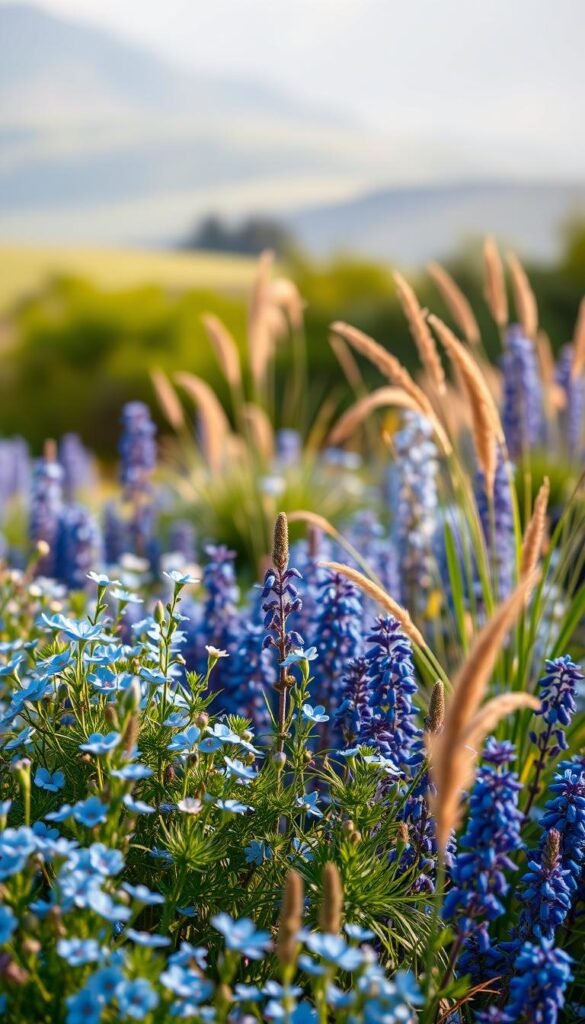
Keep your garden vibrant from spring to frost with annuals that deliver nonstop color. These three varieties thrive through heat waves and cool nights, making them perfect for low-maintenance landscapes. Their long-lasting blossoms bridge seasonal gaps while keeping your space lively.
Blue My Mind Dwarf Morning Glory blankets containers with true sapphire petals from June through October. Its trailing stems spread up to 24 inches, ideal for softening patio edges. Pair it with silver-leaved companions using smart pairing strategies to amplify its cool tones.
Laguna Sky Blue lobelia cascades like a waterfall of delicate cornflower blooms. Unlike older varieties, it won’t wilt during July’s peak heat. Plant it in hanging baskets where its 10-inch stems can spill freely, attracting hummingbirds all season.
For explosive color, Superbells Blue Moon Punch calibrachoa produces thousands of violet-blue blossoms. It thrives in raised beds and containers, needing no deadheading. As one gardener noted, “These blooms make my yard look professionally designed with zero effort.”
Use these annuals to fill empty spots in borders or create instant curb appeal. Their drought tolerance makes them perfect for low-maintenance raised beds, while their extended bloom time ensures your efforts pay off until fall’s first frost.
Elegant Blue Shrubs and Their Unique Features
Elevate your landscape’s architecture with woody plants that offer both form and function. Unlike seasonal blooms, these structural specimens create lasting impact while supporting local ecosystems.
Adding Structure With Striking Varieties
Blue Chiffon Rose of Sharon becomes a living sculpture from July through October. Its lacy petals dance on 10-foot stems, thriving in Zones 5-9 with minimal watering. You’ll enjoy watching hummingbirds flock to its nectar-rich flowers while deer steer clear.
For compact spaces, Let’s Dance Rhythmic Blue Hydrangea delivers oversized mophead clusters without pruning. This 3-foot-tall marvel blooms continuously through summer frosts, even in chilly Zone 5 winters. Its color intensifies in acidic soil, creating natural mood rings beneath your windows.
| Feature | Blue Chiffon | Rhythmic Hydrangea |
|---|---|---|
| Height | 8-12 ft | 3-4 ft |
| Bloom Period | Summer-Fall | All Summer |
| Wildlife Value | Birds/Butterflies | Pollinator Hub |
Pair these shrubs with cold-hardy evergreens for year-round structure. Their drought tolerance reduces maintenance, while their vertical lines guide eyes through your design. You’ll create privacy screens that double as art installations.
These woody wonders prove practical beauty exists. They frame smaller flowers while anchoring your space through seasons – no color fade, no replanting, just reliable elegance.
Maximizing Pollinator Attraction with Blue Plants
Transform your yard into a buzzing sanctuary by leveraging nature’s favorite color for winged visitors. Research shows blossoms in cooler tones attract 38% more pollinators than warmer hues, creating vibrant ecosystems right outside your door.
Three standout specimens turn spaces into pollinator powerhouses. Caryopteris bursts with nectar-rich clusters from August through October, feeding bees when other sources dwindle. Its compact size fits perfectly in urban plots or container displays.
For early-season action, try Blue Columbines. Their upward-facing blooms act as hummingbird landing pads while resisting deer nibbles. Pair them with Lupines to double your impact—these spiky beauties fix nitrogen in soil while hosting butterfly larvae.
| Plant | Key Pollinators | Bonus Features |
|---|---|---|
| Caryopteris | Honeybees, Bumblebees | Drought-tolerant |
| Columbines | Hummingbirds, Swallowtails | Self-seeding |
| Lupines | Monarchs, Skippers | Soil-enriching |
Stagger bloom times by mixing early and late-season varieties. You’ll provide continuous meals from spring’s first thaw until autumn frosts. This strategy supports entire lifecycles, from emerging queen bees to migrating butterflies.
Notice more birds visiting too? Many species snack on pests attracted to your blossoms. It’s a beautiful cycle—your choices create habitats while bringing dynamic energy to everyday moments outdoors.
Combining Blue Flowers and Foliage for Depth
Transform your space into a living tapestry by weaving together nature’s most calming elements. The secret lies in balancing delicate petals with structured leaves, creating dimension that invites closer inspection.
Mixing Textures and Shades for Impact
Pair velvety lamb’s ear leaves with spiky salvias for tactile contrast. Silvery foliage intensifies cool-toned petals, while deep burgundy stems add unexpected warmth. Try alternating glossy and matte surfaces along pathways—sunlight will dance across them differently each hour.
Layering Techniques to Enhance Visual Interest
Start with tall grasses as backdrops, then mid-height blooms, finishing with creeping groundcovers. This “staircase effect” guides the eye naturally through your design. Evergreen shrubs maintain structure when seasonal blossoms fade, ensuring year-round appeal.
Remember: odd numbers create harmony. Group three varieties with varying leaf shapes in triangular formations. You’ll craft a dynamic yet cohesive display that feels intentional—not overcrowded. With thoughtful pairings, your space becomes an evolving masterpiece where every layer tells its own story.

